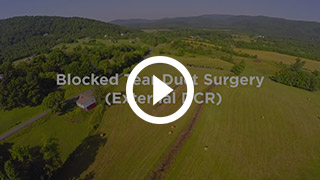Tear Duct Surgery
Dacryocystorhinostomy (DCR)
Normal Tear Drainage/Anatomy
Your tears normally drain from around your eyes through small openings in the medial (near the nose) aspect of the upper and lower eyelids. These openings are called puncta and allow the tears to pass into the canaliculi which are channels connected to the lacrimal sac (tear sac). Gravity, capillary action (‘wick-effect’), and the pumping action of the eyelids push the tears into the lacrimal sac and down into the nasolacrimal duct. The nasolacrimal empties into the nose below the inferior turbinate in the inferior meatus.
Abnormal Tear Drainage
Tearing (epiphora) may result from a small or absent lacrimal punctum, narrowing of the canaliculi, or blockage of the nasolacrimal duct. The nasolacrimal duct may become blocked from previous trauma (nasal or orbital fracture), chronic sinusitis, nasal congestion or disease, or from progressive narrowing of the duct (most common). When the nasolacrimal duct becomes blocked, your tears do not flow into the nose like they should and they may overflow onto the cheek. Pooling (stagnation) of the tears in the lacrimal sac can create repeated infections of the sac. These infections are called dacryocystitis and can be serious if untreated.
Dacryocystorhinostomy (DCR) Surgery
 Watch to learn more about Dacryocystorhinostomy (DCR) Surgery
Watch to learn more about Dacryocystorhinostomy (DCR) Surgery
What is a DCR?
Dacryocystorhinostomy is a surgery to create a new passageway for tears to drain into the nose. An incision is made at the midway point between the inside corner of the nose and the nasal bridge. The lacrimal sac is opened and the infection is addressed if present. Occasionally, tear duct stones are identified and removed. Rarely, other pathology ( such as lymphoma, sarcoidosis, benign and malignant squamous cell lesions) may be encountered and biopsied. A small opening in the bone on the side of the nose is created allowing for the lacrimal sac to drain directly into the nasal cavity. A soft silicone stent is inserted through the puncta and canaliculi into the nose to help keep the new bypass open during the healing phase.
Dacryocystorhinostomy is performed as an outpatient procedure under intravenous sedation and with local anesthetic. Dissolvable sutures are used, and there is no eye patch after surgery. Topical antibitiotic-corticosteroid eye drops are used for one week following surgery. The silicone lacrimal stent is typically removed around 6 months after DCR surgery.
What are the expectations, risks, and complications of DCR surgery?
DCR surgery successfully improves excessive tearing in more than 90% of patients. The success rate is not as high for patients with prior nasal surgery, sinus disease, or mid-facial trauma. The bypass fistula created during surgery may scar closed resulting in recurrent blockage of the tear drainage system. Repeat DCR surgery may be required if recurrent blockage occurs. Nasal bleeding requiring nasal packing may occur during surgery or anytime in the first several days following a DCR procedure. Many patients may experience decreased blinking on the operative side following surgery. This may take weeks or months to slowly improve. Infection, vision loss, and cerebrospinal (CSF) fluid leak are rare, but recognized, complications of surgeries performed in the medial canthal (inside corner of the eye and side of the nose) area.
Before/After Photos
